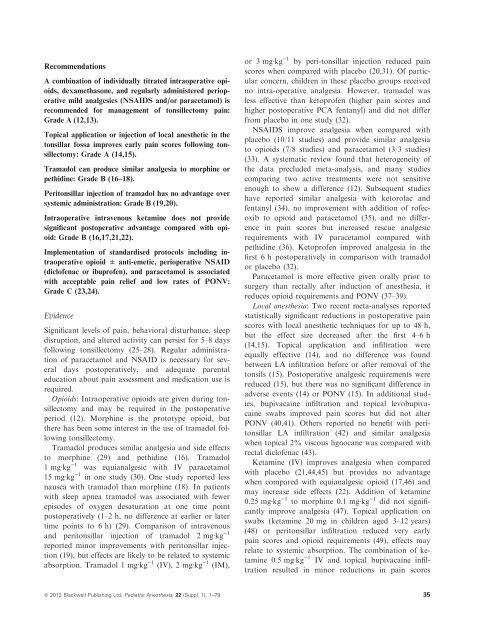Good Practice in Postoperative and Procedural Pain Management ...
Good Practice in Postoperative and Procedural Pain Management ...
Good Practice in Postoperative and Procedural Pain Management ...
You also want an ePaper? Increase the reach of your titles
YUMPU automatically turns print PDFs into web optimized ePapers that Google loves.
RecommendationsA comb<strong>in</strong>ation of <strong>in</strong>dividually titrated <strong>in</strong>traoperative opioids,dexamethasone, <strong>and</strong> regularly adm<strong>in</strong>istered perioperativemild analgesics (NSAIDS <strong>and</strong>/or paracetamol) isrecommended for management of tonsillectomy pa<strong>in</strong>:Grade A (12,13).Topical application or <strong>in</strong>jection of local anesthetic <strong>in</strong> thetonsillar fossa improves early pa<strong>in</strong> scores follow<strong>in</strong>g tonsillectomy:Grade A (14,15).Tramadol can produce similar analgesia to morph<strong>in</strong>e orpethid<strong>in</strong>e: Grade B (16–18).Peritonsillar <strong>in</strong>jection of tramadol has no advantage oversystemic adm<strong>in</strong>istration: Grade B (19,20).Intraoperative <strong>in</strong>travenous ketam<strong>in</strong>e does not providesignificant postoperative advantage compared with opioid:Grade B (16,17,21,22).Implementation of st<strong>and</strong>ardised protocols <strong>in</strong>clud<strong>in</strong>g <strong>in</strong>traoperativeopioid ± anti-emetic, perioperative NSAID(diclofenac or ibuprofen), <strong>and</strong> paracetamol is associatedwith acceptable pa<strong>in</strong> relief <strong>and</strong> low rates of PONV:Grade C (23,24).EvidenceSignificant levels of pa<strong>in</strong>, behavioral disturbance, sleepdisruption, <strong>and</strong> altered activity can persist for 5–8 daysfollow<strong>in</strong>g tonsillectomy (25–28). Regular adm<strong>in</strong>istrationof paracetamol <strong>and</strong> NSAID is necessary for severaldays postoperatively, <strong>and</strong> adequate parentaleducation about pa<strong>in</strong> assessment <strong>and</strong> medication use isrequired.Opioids: Intraoperative opioids are given dur<strong>in</strong>g tonsillectomy<strong>and</strong> may be required <strong>in</strong> the postoperativeperiod (12). Morph<strong>in</strong>e is the prototype opioid, butthere has been some <strong>in</strong>terest <strong>in</strong> the use of tramadol follow<strong>in</strong>gtonsillectomy.Tramadol produces similar analgesia <strong>and</strong> side effectsto morph<strong>in</strong>e (29) <strong>and</strong> pethid<strong>in</strong>e (16). Tramadol1mgÆkg )1 was equianalgesic with IV paracetamol15 mgÆkg )1 <strong>in</strong> one study (30). One study reported lessnausea with tramadol than morph<strong>in</strong>e (18). In patientswith sleep apnea tramadol was associated with fewerepisodes of oxygen desaturation at one time po<strong>in</strong>tpostoperatively (1–2 h, no difference at earlier or latertime po<strong>in</strong>ts to 6 h) (29). Comparison of <strong>in</strong>travenous<strong>and</strong> peritonsillar <strong>in</strong>jection of tramadol 2 mgÆkg )1reported m<strong>in</strong>or improvements with peritonsillar <strong>in</strong>jection(19), but effects are likely to be related to systemicabsorption. Tramadol 1 mgÆkg )1 (IV), 2 mgÆkg )1 (IM),or 3 mgÆkg )1 by peri-tonsillar <strong>in</strong>jection reduced pa<strong>in</strong>scores when compared with placebo (20,31). Of particularconcern, children <strong>in</strong> these placebo groups receivedno <strong>in</strong>tra-operative analgesia. However, tramadol wasless effective than ketoprofen (higher pa<strong>in</strong> scores <strong>and</strong>higher postoperative PCA fentanyl) <strong>and</strong> did not differfrom placebo <strong>in</strong> one study (32).NSAIDS improve analgesia when compared withplacebo (10/11 studies) <strong>and</strong> provide similar analgesiato opioids (7/8 studies) <strong>and</strong> paracetamol (3/3 studies)(33). A systematic review found that heterogeneity ofthe data precluded meta-analysis, <strong>and</strong> many studiescompar<strong>in</strong>g two active treatments were not sensitiveenough to show a difference (12). Subsequent studieshave reported similar analgesia with ketorolac <strong>and</strong>fentanyl (34), no improvement with addition of rofecoxibto opioid <strong>and</strong> paracetamol (35), <strong>and</strong> no difference<strong>in</strong> pa<strong>in</strong> scores but <strong>in</strong>creased rescue analgesicrequirements with IV paracetamol compared withpethid<strong>in</strong>e (36). Ketoprofen improved analgesia <strong>in</strong> thefirst 6 h postoperatively <strong>in</strong> comparison with tramadolor placebo (32).Paracetamol is more effective given orally prior tosurgery than rectally after <strong>in</strong>duction of anesthesia, itreduces opioid requirements <strong>and</strong> PONV (37–39).Local anesthesia: Two recent meta-analyses reportedstatistically significant reductions <strong>in</strong> postoperative pa<strong>in</strong>scores with local anesthetic techniques for up to 48 h,but the effect size decreased after the first 4–6 h(14,15). Topical application <strong>and</strong> <strong>in</strong>filtration wereequally effective (14), <strong>and</strong> no difference was foundbetween LA <strong>in</strong>filtration before or after removal of thetonsils (15). <strong>Postoperative</strong> analgesic requirements werereduced (15), but there was no significant difference <strong>in</strong>adverse events (14) or PONV (15). In additional studies,bupivaca<strong>in</strong>e <strong>in</strong>filtration <strong>and</strong> topical levobupivaca<strong>in</strong>eswabs improved pa<strong>in</strong> scores but did not alterPONV (40,41). Others reported no benefit with peritonsillarLA <strong>in</strong>filtration (42) <strong>and</strong> similar analgesiawhen topical 2% viscous lignocane was compared withrectal diclofenac (43).Ketam<strong>in</strong>e (IV) improves analgesia when comparedwith placebo (21,44,45) but provides no advantagewhen compared with equianalgesic opioid (17,46) <strong>and</strong>may <strong>in</strong>crease side effects (22). Addition of ketam<strong>in</strong>e0.25 mgÆkg )1 to morph<strong>in</strong>e 0.1 mgÆkg )1 did not significantlyimprove analgesia (47). Topical application onswabs (ketam<strong>in</strong>e 20 mg <strong>in</strong> children aged 3–12 years)(48) or peritonsillar <strong>in</strong>filtration reduced very earlypa<strong>in</strong> scores <strong>and</strong> opioid requirements (49), effects mayrelate to systemic absorption. The comb<strong>in</strong>ation of ketam<strong>in</strong>e0.5 mgÆkg )1 IV <strong>and</strong> topical bupivaca<strong>in</strong>e <strong>in</strong>filtrationresulted <strong>in</strong> m<strong>in</strong>or reductions <strong>in</strong> pa<strong>in</strong> scoresª 2012 Blackwell Publish<strong>in</strong>g Ltd, Pediatric Anesthesia, 22 (Suppl. 1), 1–79 35
















